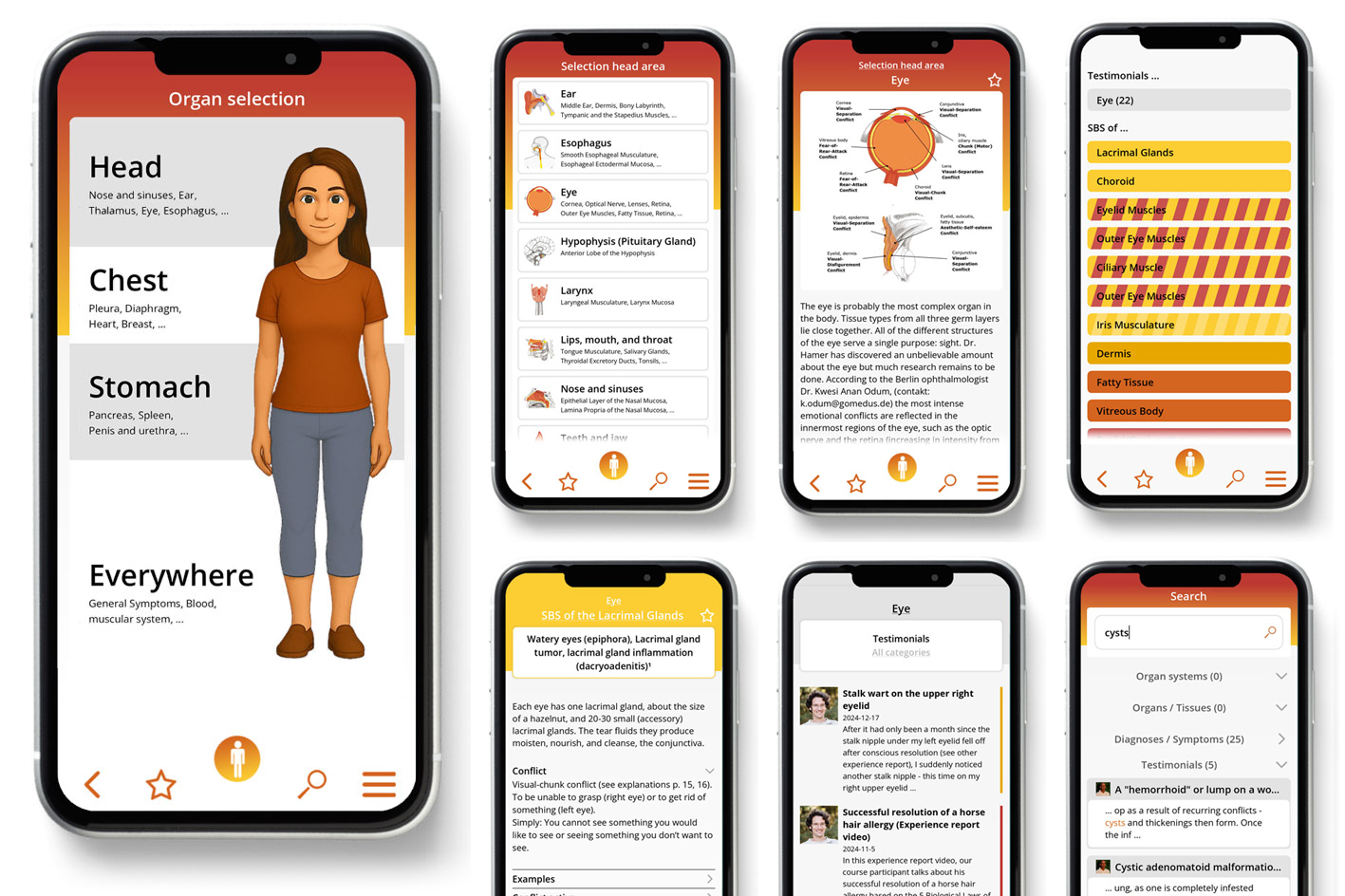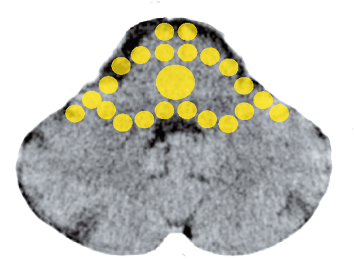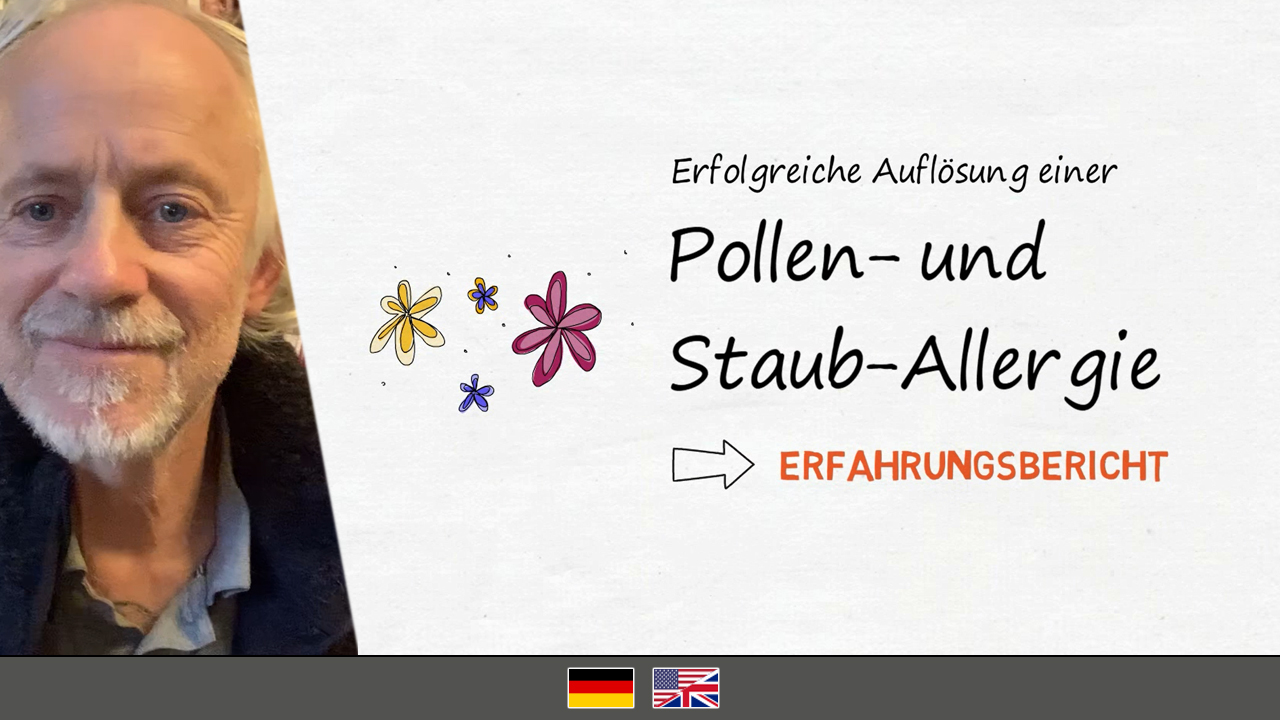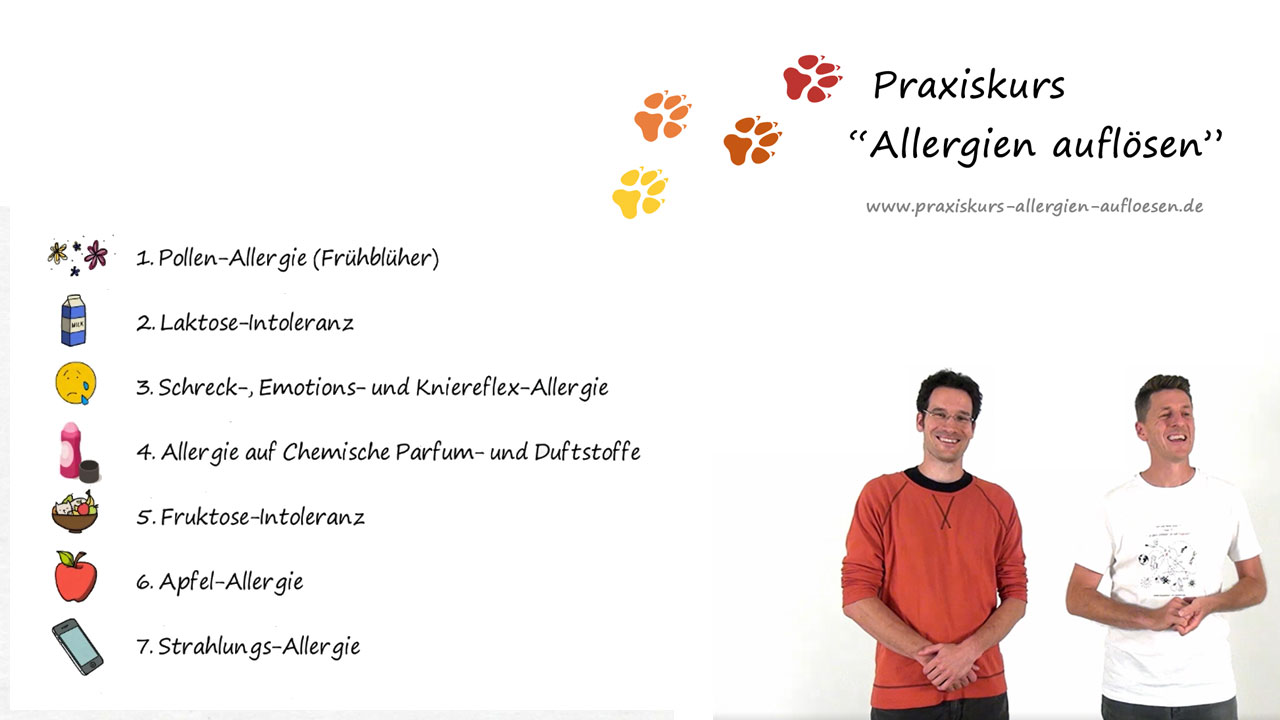 The information on this site is from one of the most famous books about the New Medicine (GNM / 5BN): "The Psychic Roots of Diseases" by Björn Eybl. Since September 2025, it is available in the form of an app with many additional features.
The information on this site is from one of the most famous books about the New Medicine (GNM / 5BN): "The Psychic Roots of Diseases" by Björn Eybl. Since September 2025, it is available in the form of an app with many additional features.It was written in german and was translated into more than 10 languages already. German is not freely available, as the rights are held by a publisher, but all these translations are available as ebooks / PDFs for free, as a gift of Björn for you, for the New Earth, for a new time.
In cooperation with Björn, it is splitted on "Disease is Different" into the sections by organ systems and combined with the real cases of our international testimonial / report archive of the related organ system.
NOSE AND SINUSES
It is said, that of all the senses, the sense of smell has the strongest direct connection to the subconscious. Perhaps this is the reason why the nose reacts the fastest to an SBS in comparison to all other organs and why triggers (allergies) are so frequent here.
The nasal cavity (cavum nasi) is connected to the four hollow sinuses between the nose and eyes (sinus paranasales) by narrow canals. The sinuses of the cheeks (sinus maxillaris), the sinuses of the forehead (sinus frontalis), the sinuses behind the eyes (sinus sphenoidalis), the ethmoidal cells (cellulae ethmoidales), also between the nose and eyes, and the nasal cavity are lined with endodermal intestinal mucosa and the ectodermal squamous epithelium that lies over it.

Olfactory Mucosa
Stinking conflict or
territorial-scent conflict
Nasal Mucosa
(ectodermal)
Stinking conflict or
scent conflict
Nasal Mucosa
(endodermal)
Chunk-stinking or
scent conflict


Cold (rhinitis), sinus infection (sinusitis)1
Allergic “cold“ (runny nose), hay fever, dust mite allergy (allergic rhinitis)
Same SBS as above. According to CM, allergies are caused by hypersensitivity of the immune system. The body‘s own defense cells (T and B-lymphocytes) are said to suddenly turn against harmless substances like pollen, excrement, and house dust mites. Actually, allergies are always based on triggers (see: p. 24). The nose is often affected. In the case of anaphylactic shock, there was the danger of death during the conflict.
| Examples |  A 66-year-old retiree has suffered for the last 34 years from an extreme pollen allergy affecting the nose and throat membranes, as well as the conjunctiva of the eye. The allergy begins every year in May and can only be tolerated with the injection of cortisone and other strong medications. Conflict history: Forty years ago the young man, 24 at the time, and his wife wanted to have a child. Following a premature birth, the child died. Five years later, the head of obstetrics promises to do all that he can so that they are successful this time. When the woman gets pregnant again, she stays at the clinic starting from the third month so she can stay in bed until the child arrives. After 6½ months — on the 15th of May — she has another premature birth. Stinking conflict regarding the mucosa of the nose. Not being able to “swallow“ the premature birth — related to the mucosa of the throat and visual-separation conflict — affecting the conjunctiva (eye). As a trigger, the May pollen becomes anchored firmly in the subconscious. The child weighs 1.5 kg (3.3 lbs) and is brought to another hospital where he is laid in an incubator. The doctor is not sure “whether he will survive the transport.“The son is now 35 years old and suffers, probably due to the birth trauma, from the same pollen allergy as his father. (Archive B. Eybl) A 66-year-old retiree has suffered for the last 34 years from an extreme pollen allergy affecting the nose and throat membranes, as well as the conjunctiva of the eye. The allergy begins every year in May and can only be tolerated with the injection of cortisone and other strong medications. Conflict history: Forty years ago the young man, 24 at the time, and his wife wanted to have a child. Following a premature birth, the child died. Five years later, the head of obstetrics promises to do all that he can so that they are successful this time. When the woman gets pregnant again, she stays at the clinic starting from the third month so she can stay in bed until the child arrives. After 6½ months — on the 15th of May — she has another premature birth. Stinking conflict regarding the mucosa of the nose. Not being able to “swallow“ the premature birth — related to the mucosa of the throat and visual-separation conflict — affecting the conjunctiva (eye). As a trigger, the May pollen becomes anchored firmly in the subconscious. The child weighs 1.5 kg (3.3 lbs) and is brought to another hospital where he is laid in an incubator. The doctor is not sure “whether he will survive the transport.“The son is now 35 years old and suffers, probably due to the birth trauma, from the same pollen allergy as his father. (Archive B. Eybl) Allergic to wine: “The first time“ — A schoolboy is in love with one of the girls in his class. One evening, during a vacation week, the young couple are allowed to go out and celebrate by themselves. Together, they buy two liters of white wine and drink it all. The girl takes the drunken schoolboy by the hand and leads him to a mattress on the floor. They want to sleep together but the boy is too drunk = stinking conflict. Whenever he drinks wine, allergic sniffles are triggered in the repair phase. (Archive B. Eybl) Allergic to wine: “The first time“ — A schoolboy is in love with one of the girls in his class. One evening, during a vacation week, the young couple are allowed to go out and celebrate by themselves. Together, they buy two liters of white wine and drink it all. The girl takes the drunken schoolboy by the hand and leads him to a mattress on the floor. They want to sleep together but the boy is too drunk = stinking conflict. Whenever he drinks wine, allergic sniffles are triggered in the repair phase. (Archive B. Eybl) A 17-year-old teenager had a house-dust allergy for two years. In a conversation with an NM therapist, it turned out that he had been suffering a lot for the last two years, because he didn’t have a girlfriend. He always became moody at home (the reason he reacted to house-dust) after he sees his friend with his pretty girlfriend. = Stink conflict that he doesn’t have a girlfriend too. He got his first serious allergy attack after his first love broke up with him. As “therapy,” his therapist advised him to talk to his compassionate father about his situation. During the conversation, his father revealed to him that as a youth he also had similar feelings and went through similar disappointments. Since then, he has been able to deal with the issue in a more relaxed way. Now, he realizes that all this is “normal.” DMSO and colloidal silver were applied externally. After a short time, his allergy symptoms subsided completely. (Archive B. Eybl) A 17-year-old teenager had a house-dust allergy for two years. In a conversation with an NM therapist, it turned out that he had been suffering a lot for the last two years, because he didn’t have a girlfriend. He always became moody at home (the reason he reacted to house-dust) after he sees his friend with his pretty girlfriend. = Stink conflict that he doesn’t have a girlfriend too. He got his first serious allergy attack after his first love broke up with him. As “therapy,” his therapist advised him to talk to his compassionate father about his situation. During the conversation, his father revealed to him that as a youth he also had similar feelings and went through similar disappointments. Since then, he has been able to deal with the issue in a more relaxed way. Now, he realizes that all this is “normal.” DMSO and colloidal silver were applied externally. After a short time, his allergy symptoms subsided completely. (Archive B. Eybl) |
|---|---|
| Phase | The length of the conflict activity can vary between just a few seconds and several days. Usually, the conflict activity lasts briefly and then the repair phase lasts longer = persistent repair — allergic cold. |
| Note | An additional conjunctivitis points to a visual-separation conflict, a swollen throat to a conflict of not- wanting-to-swallow-something, tightened bronchi to a territorial-fear conflict or shock-fright conflict. (A conflict can start more than one SBS.) |
| Questions | See also above. When did it begin? Work out the accompanying circumstances: Pollen trigger? Which? In which month is it in the air? Which stress was experienced outside? (Find the correspondence with the time of the conflict). Triggered by cold/heat? (Time of year, gets better on vacation or while travelling)? Dust mite trigger: Stress in the house at the time in question? Moving house? Food trigger? (Stress while eating/drinking, argument at the table/in a restaurant/in the cafeteria)? Am I the only one in the family with allergies? (Determine the family issue)? What sensitized me? (Pregnancy, birth, childhood)? > Questions for the mother: what stresses her? Will I allow myself to leave this conditioning behind me? What could help? (Discussion, healing-regression meditation)? |
| Therapy | Find the conflict and conditioning and, if possible, resolve them in real life. If this fails, you can try a CM desensitization. Antihistamines are useful in acute or threatening conditions, but not for long-term intake. Before that, the gentle measures on p. 189 should be tried. |
1 See Dr. Hamer, Charts, pp. 122, 134

Purulent cold, nose polyps, suppuration of the sinuses
(e.g., empyema of the frontal sinus)
Colds with yellow pus and suppuration of the sinuses indicate that either remaining pockets of endodermal intestinal mucosa or mesodermal connective tissue (the lamina propria underneath the epithelium) are being degraded.
Nose polyps are bulges of this endodermal mucous membrane. They can develop in the nasal cavity or in the sinuses and hinder breathing.
| Conflict | Chunk—stinking conflict. Not wanting to smell something: “This situation stinks.“ “To get a nose-full.“ “Something stinks about it.“ Also, scent conflict: not being able to sense something. Not being able to sense what will happen. |
|---|---|
| Examples |  A young woman frequently has trouble with her parents. Most visits end disharmoniously. With her partner, she also suffers several bitter disappointments = stinking conflict — “Having it up to here (nose) with the constant arguing!“ After three years of almost constantly purulent sinuses, the patient is suddenly symptom-free when the relationship with her parents suddenly takes a turn for the better = resolved conflict. (Archive B. Eybl) A young woman frequently has trouble with her parents. Most visits end disharmoniously. With her partner, she also suffers several bitter disappointments = stinking conflict — “Having it up to here (nose) with the constant arguing!“ After three years of almost constantly purulent sinuses, the patient is suddenly symptom-free when the relationship with her parents suddenly takes a turn for the better = resolved conflict. (Archive B. Eybl) An executive staff member of a technical office must look on as her boss makes one wrong decision after the other and steers the company in the direction of bankruptcy. More and more customers turn away. Once a month, she has a purulent nose and sinus infection. “I have had it up to here (nose) with this mismanagement!“ = recurring stinking conflict. After the company goes bankrupt, the patient finds herself an interesting new job (= completely resolved conflict) and from that point on has no more sinus infections. (Archive B. Eybl) An executive staff member of a technical office must look on as her boss makes one wrong decision after the other and steers the company in the direction of bankruptcy. More and more customers turn away. Once a month, she has a purulent nose and sinus infection. “I have had it up to here (nose) with this mismanagement!“ = recurring stinking conflict. After the company goes bankrupt, the patient finds herself an interesting new job (= completely resolved conflict) and from that point on has no more sinus infections. (Archive B. Eybl) A woman loves the warmer climes. For many years, she lived in a large German city and always had clogged sinuses during the cold seasons. For her, it particularly stunk when she had to wait for a bus or a train in bad weather. The conflict finally resolved when she got her driver’s license at the age of 33 and could drive a car wherever and whenever she wanted. At that point, she was no longer dependent on public transportation. (Archive Antje Scherret) A woman loves the warmer climes. For many years, she lived in a large German city and always had clogged sinuses during the cold seasons. For her, it particularly stunk when she had to wait for a bus or a train in bad weather. The conflict finally resolved when she got her driver’s license at the age of 33 and could drive a car wherever and whenever she wanted. At that point, she was no longer dependent on public transportation. (Archive Antje Scherret) |
| Conflict-active | Increased function, growth of a flat-growing tumor of absorptive quality or a cauliflower-shaped tumor of secretory quality (nasal polyps). |
| Bio. function | With more cells in the mucous membrane, one is better able to analyze and/or eliminate the smell. |
| Repair phase | Function normalization, inflammation of the sinuses, reduction of thickening of the mucosa or polyps by fungi or bacteria. Yellow-pus “cold“ (runny nose), possibly mild fever and night sweats. During conflict activity, the nose may run due to increased production of clear nasal secretions (mostly recurring—conflict). Chronic discharge from the sinuses can cause sinus (forehead) headaches. |
| Repair crisis | Pain, feeling of being cold, possibly chills. |
| Therapy | Questions: see previous page. The conflict is resolved. Support the healing process. In the case of recurrence, find out what the conflict and conditioning are and resolve them. See also: measures on p. 189. When conflict resolution is not possible, nasal polyps above a certain size should be surgically removed (infundibulotomy) because of the possibility of respiratory obstruction. |

Loss or impairment of the sense of smell (anosmia or hyposmia)1
Colds cause insufficient air to reach the olfactory-mucosa (regio olfactoria) at the roof of the mouth.
There is also an impairment of the sense of smell with a cold, i.e., a conflict of the olfactory-mucosa (fila olfactoria). That is what this SBS is about:
| Conflict | Stinking conflict — not wanting to smell something. “This situation stinks.“ “I’ve had it up to here (nose)“ “Something stinks.“ Also, a scent conflict: not being able to sense/scent/sniff something. Not being able to sense/scent/sniff what or when something will happen to the person. (Dog stretches his nose up to sniff. He picks up the scent, he can assess the situation). This olfactory mucosa conflict probably has a territorial component, which is likely to differentiate it from the rest of nasal mucosa SBSs (territory-scent conflict). |
|---|---|
| Examples |  A mother gets a phone call from her son, her only child. He hurriedly tells her that he and his girlfriend are getting married. He says that the wedding will be kept to a minimum and so she will only be invited to the dinner after the civil ceremony = scent conflict affecting the olfactory mucosa. During the conversation there is a foul, sour smell from the kitchen‘s garbage can in the air. For two weeks, the patient has this foul smell in her nose. She thinks that something about her clothing must have this smell and asks others whether they smell it too = smell paranoia in the active-phase. A mother gets a phone call from her son, her only child. He hurriedly tells her that he and his girlfriend are getting married. He says that the wedding will be kept to a minimum and so she will only be invited to the dinner after the civil ceremony = scent conflict affecting the olfactory mucosa. During the conversation there is a foul, sour smell from the kitchen‘s garbage can in the air. For two weeks, the patient has this foul smell in her nose. She thinks that something about her clothing must have this smell and asks others whether they smell it too = smell paranoia in the active-phase.Note: here, we have a so-called smell-constellation, i.e., there is one Hamer focus to the right and one Hamer focus to the left of the olfactory bulb in the cerebral cortex. (Archive B. Eybl) |
| Conflict-active | Impaired functioning of the olfactory mucosa (hyposmia or anosmia) without cell degradation. Aromatic material cannot be discerned completely or only to a limited extent. One can smell pungent odors like ammonia or vinegar because they stimulate the other nose membranes. |
| Bio. function | The blocking-off of unbearable stenches. |
| Repair phase | Restoration of sense of smell — no cold. |
| Repair crisis | Sudden loss of smell, analog to a sudden loss of hearing = sudden, brief impairment of the sense of smell. |
| Note | In constellation, there is smell confusion (smell paranoia, e.g., cacosmia). |
| Therapy | Questions: see above. Determine the conflict and conditioning and, if possible, resolve them in real life. Find out where the love is — there you’ll find the solution. See cold (rhinitis), p. 189. |
1 See Dr. Hamer, Charts, pp. 141, 145
Nosebleeds
Possible causes
- Tendency toward nosebleeds in the repair phase, especially during the repair phase crisis of a stinking or scent conflict. The healing sores of the nasal mucosa bleed (see: p.188).
- Very strong nosebleeds due to thinner blood. See: tendency to bleed p. 168.
Therapy
- Depends on the cause.
- Bleeding: Bow the head slightly forward, close the nose with thumb and forefinger for 10 minutes, cool the back of the neck.
- Hildegard of Bingen: dill-achillea powder special recipe.
All experience reports on the organ system «Nose and Sinuses» from the International Report Archive:
| Author | Title and Overview | Keywords | ||||
|---|---|---|---|---|---|---|
 | 2025/08/16   Andreas, 33 years old, came to my practice in June because of his allergy to “grasses.” He couldn't say exactly what he was allergic to. His allergy had been present for about three years... | hay fever | ||||
 | 2025/08/01   When I was seven years old, my parents separated. My mother remarried and we moved to another city. In the spring/summer, I saw my biological father for the last time on a walk with my little brother. He told us it would be better for us children if he didn't come to visit again. (Visual separation conflict, conjunctiva of the eyes and weather conflict affecting the nasal mucosa) ... | |||||
2025/07/10   Hello, my name is Sabrina and this is my experience report on the allergy resolution course. I had been struggling with severe hay fever for 24 years ...  | ||||||
2025/04/18   For years, I had a runny nose right after waking up. My nose would always start to tingle, and within seconds it would fill with a mucous that wanted to come out immediately. | ||||||
 | 2025/03/05   My dog has a cold and I let the healing process run its course. I always find it difficult to apply Germanic medicine (5BN) to animals. Not because it's not right, but because communication doesn't work the same way as with people. It takes a lot of observation, knowing the dog and empathy. | Sniffles | ||||
2024/11/05   In this experience report video, our course participant talks about his successful resolution of a horse hair allergy based on the 5 Biological Laws of Nature. For 35 years he had severe symptoms on contact with horse hair and was able to find and resolve the causal situation! Congratulations and thank you very much for sharing this valuable experience!  | ||||||
2024/10/30   In this testimonial video, our course participant talks about his successful resolution of dust and pollen allergies based on the 5 Biological Laws of Nature. For over 30 years, his nose had been continuously closed, and for several months now he has finally been able to breathe and smell through it again! Congratulations and a thousand thanks for sharing this valuable experience!  | ||||||
2024/05/15   In this testimonial video, Tanja talks about her successful resolution of hay fever / allergic rhinitis based on the 5 Biological Laws of Nature. This has existed for three years since 2019 and has now been absent for the last two years. Congratulations and a thousand thanks for sharing this valuable experience (in german, but you can activate english subtitles)!  | Allergy, hayfever | |||||
2021/06/30    These are the testimonials (in brief) of the first seven successfully resolved allergies of the participants of our practice course "Resolving Allergies". The reports are available as text and video (the video is in german, but has english and spanish subtitles):  | Track, resolving allergies | |||||
 | 2020/02/09   At the first U-examination, the topic of vaccinations came up and that she didn't want to do this in the first year of life. As the second appointment approached, she was worried with an active scent conflict, whether this stressful topic would come up again. | Scent conflict | ||||
 | 2019/08/26   At work, the person concerned was confronted out of the blue with an accusation from the team leader that he felt was completely inaccurate. After a week of forced thinking, the conflict was resolved following a clarifying discussion with the head of department. | Scent conflict, stink conflict, cold, flu |
